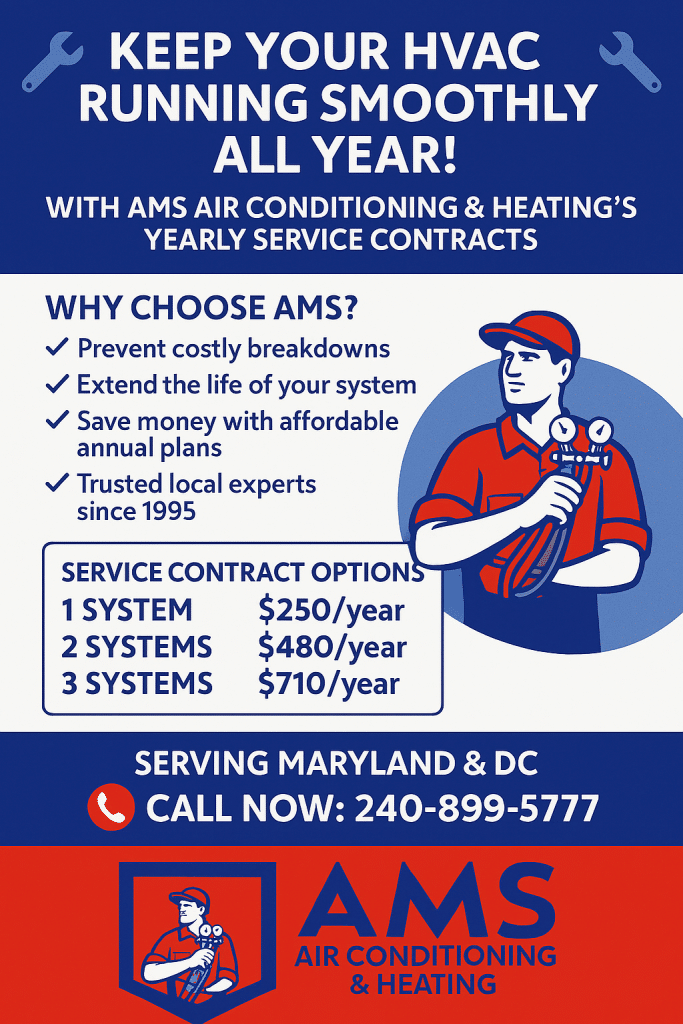As the leaves begin to fall and the crisp autumn air settles in, it’s time to prepare your home for colder weather. One of the most important tasks is ensuring your heating system is ready to keep you warm and safe throughout the winter. Whether you use a furnace, boiler, or heat pump, starting your system properly can prevent breakdowns, improve energy efficiency, and extend the life of your equipment.
At AMS Air Conditioning, we specialize in helping homeowners in Rockville, Maryland, and surrounding areas get their HVAC systems ready for the season. In this guide, we’ll walk you through everything you need to know to start your heating system for the first time this year.
Why Seasonal Heating System Preparation Matters
Starting your heating system without proper preparation can lead to:
Reduced efficiency and higher energy bills
Unpleasant odors or noises
Risk of carbon monoxide leaks
Unexpected breakdowns during cold weather
By following these steps, you’ll ensure your system runs smoothly and safely all season long.
Step 1: Inspect Your Heating System
Before turning anything on, do a thorough visual inspection:
Clear away dust, debris, and clutter from around the unit.
Make sure vents and registers are open and unobstructed.
Look for visible signs of wear, rust, or leaks on the furnace or boiler.
If you notice anything unusual, it’s best to call a professional HVAC technician for a closer look.
Step 2: Replace or Clean the Air Filter
A clean air filter is essential for proper airflow and system efficiency. Dirty filters can cause your system to work harder, leading to higher energy costs and potential damage.
Locate your filter and check its condition.
Replace disposable filters or clean reusable ones.
Set a reminder to check your filter monthly during the heating season.
Pro Tip: Use high-efficiency filters rated MERV 8–13 for better indoor air quality.
Step 3: Test Your Thermostat
Your thermostat controls when and how your heating system operates. Make sure it’s functioning correctly:
Switch from cooling to heating mode.
Set the temperature a few degrees above room temperature to test activation.
If you have a programmable thermostat, update your schedule for fall and winter.
Consider upgrading to a smart thermostat for better control and energy savings.
Step 4: Listen and Smell During Startup
When you first turn on the heat:
A burning smell is common—it’s usually dust burning off the heat exchanger.
This smell should disappear within a few minutes.
Listen for unusual noises like banging, rattling, or squealing, which could indicate mechanical issues.
If the smell persists or the noises are loud, shut off the system and contact AMS Air Conditioning at 240-899-5777.
Step 5: Check Carbon Monoxide Detectors
If your heating system uses natural gas, propane, or oil, carbon monoxide safety is critical:
Test all CO detectors in your home.
Replace batteries and check expiration dates.
Install detectors on every floor, especially near sleeping areas.
Carbon monoxide is odorless and deadly—don’t take chances.
Step 6: Schedule a Professional Heating Tune-Up
Even if everything seems fine, a seasonal HVAC inspection by a licensed technician can:
Identify hidden issues before they become costly repairs
Improve system efficiency and performance
Extend the lifespan of your equipment
At AMS Air Conditioning, our certified technicians provide comprehensive heating system tune-ups. We check burners, heat exchangers, safety controls, and more.
📞 Call us today at 240-899-5777 to schedule your heating system service.
Step 7: Bleed Radiators (If You Have Them)
If your home uses hot water radiators:
Turn on the heat and wait for the system to warm up.
Use a radiator key to bleed trapped air until water flows steadily.
This improves heat distribution and system efficiency.
Repeat this process for each radiator in your home.
Step 8: Check for Air Leaks and Insulation
Your heating system works best when your home retains heat efficiently:
Inspect windows and doors for drafts.
Use weatherstripping or caulk to seal gaps.
Check attic and wall insulation levels.
Improving insulation can reduce heating costs by up to 20%.
Step 9: Review Your Energy Bills
Compare your current energy usage to previous years:
Sudden spikes may indicate system inefficiency.
Consider a home energy audit to identify areas for improvement.
AMS Air Conditioning offers energy-saving consultations to help you lower your utility bills.
Step 10: Know When to Upgrade
If your heating system is:
Over 15 years old
Frequently breaking down
Producing uneven heat
…it may be time to consider a new energy-efficient system. Modern furnaces and heat pumps offer better performance and lower operating costs.
We offer free estimates and expert guidance on choosing the right system for your home.
Why Choose AMS Air Conditioning?
AMS Air Conditioning is your trusted HVAC partner in Rockville, Maryland. We provide:
Expert heating system maintenance and repair
Fast, friendly service
Transparent pricing
Emergency support
Whether you need a tune-up, repair, or full system replacement, we’re here to help.
Check out our service contracts that include filter and seasonal tuneups and checkups at https://ams-airconditioning.com/service-contract/
📞 Call us at 240-899-5777 or visit www.ams-airconditioning.com to schedule your appointment today.
Final Thoughts
Starting your heating system properly is one of the best ways to ensure comfort, safety, and efficiency throughout the winter. With a little preparation—and help from AMS Air Conditioning—you can enjoy peace of mind and a warm home all season long.
